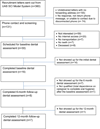Effect of a home telecare program on oral health among adults with tetraplegia: a pilot study
- PMID: 23318557
- PMCID: PMC3628960
- DOI: 10.1038/sc.2012.176
Effect of a home telecare program on oral health among adults with tetraplegia: a pilot study
Abstract
Study design: one group pre- and post-test design.
Objectives: The primary aim was to examine both the short- and long-term effects of an oral home telecare program on improving gingival health among adults with tetraplegia.
Methods: Eight adults with tetraplegia participated. The oral home telecare program consisted of individualized oral hygiene training in the use of assistive devices (powered toothbrush and adapted flosser and/or oral irrigator) using personal computer-based videoconferencing between each participant and an occupational therapist. Training was conducted on an average of five 15-30 min sessions across 3 months. During these training sessions, supervised practice of oral hygiene, and provision of immediate corrective feedback and positive reinforcement in the use of adaptive oral hygiene devices was emphasized. Gingival health assessment using the Löe-Silness gingival index (LSGI) was conducted at baseline, 6 and 12 months.
Results: From baseline to 6 months, participants showed statistically significant differences (that is, improvement with less gingival inflammation) in their LSGI scores (z=2.18, P=.03). From baseline to 12 months, participants also showed a statistically significant difference (that is, improvement, z=2.03; P=0.04) in their LSGI scores.
Conclusion: This study indicates that preventive oral home telecare with repeated oral hygiene training in the use of adaptive devices improved gingival health at 6 and 12 months among adults with tetraplegia.
Conflict of interest statement
The author declares that they have no conflict of interest.
Similar articles
-
Oral home telecare for adults with tetraplegia: a feasibility study.Spec Care Dentist. 2009 Sep-Oct;29(5):204-9. doi: 10.1111/j.1754-4505.2009.00094.x. Spec Care Dentist. 2009. PMID: 19740151
-
Effect of a multi-faceted intervention on gingival health among adults with systemic sclerosis.Clin Exp Rheumatol. 2011 Mar-Apr;29(2 Suppl 65):S26-32. Epub 2011 May 12. Clin Exp Rheumatol. 2011. PMID: 21586215 Free PMC article. Clinical Trial.
-
Impact of oral health education on oral hygiene knowledge, practices, plaque control and gingival health of 13- to 15-year-old school children in Bangalore city.Int J Dent Hyg. 2013 May;11(2):126-33. doi: 10.1111/j.1601-5037.2012.00563.x. Epub 2012 Jun 30. Int J Dent Hyg. 2013. PMID: 22747831
-
Improving oral hygiene for patients.Nurs Stand. 2015 Jan 13;29(19):44-50. doi: 10.7748/ns.29.19.44.e9383. Nurs Stand. 2015. PMID: 25563127 Review.
-
Oral health education strategies for patients living with cardiovascular disease within hospital settings: a scoping review.Front Public Health. 2024 Jun 19;12:1389853. doi: 10.3389/fpubh.2024.1389853. eCollection 2024. Front Public Health. 2024. PMID: 38962771 Free PMC article.
Cited by
-
Oral Irrigation Devices: A Scoping Review.Clin Exp Dent Res. 2024 Jun;10(3):e912. doi: 10.1002/cre2.912. Clin Exp Dent Res. 2024. PMID: 38881230 Free PMC article.
-
Factors Associated With Regular Dental Care in People With Spinal Cord Injury: A Secondary Analysis of Data From the FRASCI Study.Top Spinal Cord Inj Rehabil. 2023 Summer;29(3):71-79. doi: 10.46292/sci22-00052. Epub 2023 Aug 16. Top Spinal Cord Inj Rehabil. 2023. PMID: 38076285 Free PMC article.
-
Implementation of a Teledentistry Platform for Dental Emergencies for the Elderly in the Context of the COVID-19 Pandemic in Chile.Biomed Res Int. 2022 Mar 22;2022:6889285. doi: 10.1155/2022/6889285. eCollection 2022. Biomed Res Int. 2022. PMID: 35330690 Free PMC article.
-
Dental Care Access and the Elderly: What Is the Role of Teledentistry? A Systematic Review.Int J Environ Res Public Health. 2020 Dec 4;17(23):9053. doi: 10.3390/ijerph17239053. Int J Environ Res Public Health. 2020. PMID: 33291719 Free PMC article.
-
Features of Structured, One-to-One Videoconference Interventions That Actively Engage People in the Management of Their Chronic Conditions: Scoping Review.J Med Internet Res. 2025 Feb 26;27:e58543. doi: 10.2196/58543. J Med Internet Res. 2025. PMID: 40009439 Free PMC article.
References
-
- Lancashire P, Janzen J, Zach GA, Addy M. The oral hygiene and gingival health of paraplegic inpatients--a cross-sectional survey. Journal of clinical periodontology. 1997;24(3):3. - PubMed
-
- Stiefel DJ, Truelove EL, Persson RS, Chin MM, Mandel LS. A comparison of oral health in spinal cord injury and other disability groups. Special Care in Dentistry. 1993;13(6):229–235. - PubMed
-
- Bronte S. Oral health care for individuals with tetraplegia due to spinal cord injury: A pilot study. Journal of Oral Health and Disability. 2001;2(1):7.
-
- Yuen HK, Wolf BJ, Bandyopadhyay D, Magruder KM, Selassie AW, Salinas CF. Factors that limit access to dental care for adults with spinal cord injury. Special care in dentistry : official publication of the American Association of Hospital Dentists, the Academy of Dentistry for the Handicapped, and the American Society for Geriatric Dentistry. 2010 Jul-Aug;30(4):151–156. - PMC - PubMed
Publication types
MeSH terms
Grants and funding
LinkOut - more resources
Full Text Sources
Other Literature Sources
Medical


